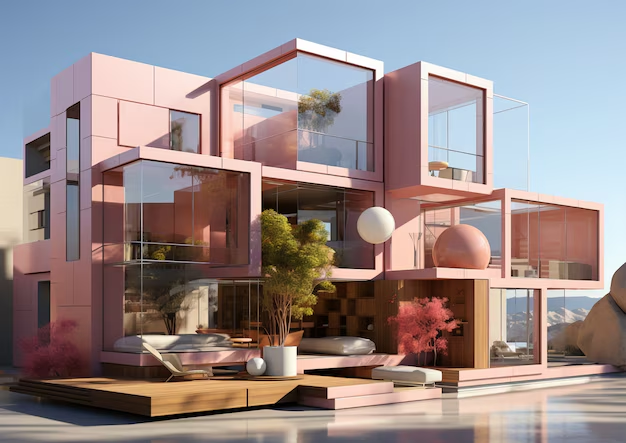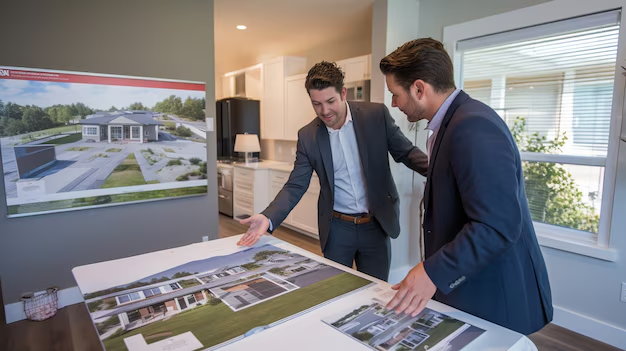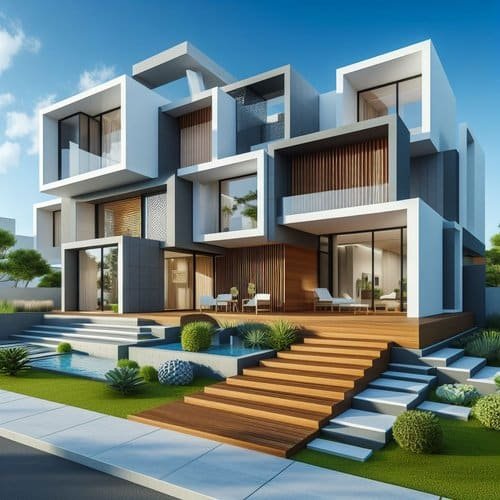Residential architecture is more than just designing functional living spaces; it’s about creating environments that are aesthetically pleasing, sustainable, and adaptable to the future needs of inhabitants. As we move further into the 21st century, the role of residential architecture continues to evolve, driven by technological advancements, shifting societal norms, and growing environmental concerns.
In this article, we will explore the art of residential architecture, examining how innovative designs are shaping homes that meet the needs of modern living while anticipating the future. From sustainable construction techniques and technological advancements to the integration of natural elements, we will explore the various factors that make residential architecture an art form and how it is moving toward designing homes for the future.
Key Takeaways
- Residential architecture today is driven by functionality, sustainability, aesthetics, and technology integration.
- Homes are increasingly designed to be adaptable, with multifunctional spaces and modular components.
- Sustainability is becoming the standard for residential design, with a focus on energy efficiency, green materials, and renewable energy.
- Technology is transforming the way we live in our homes, from smart home devices to home automation systems.
- The future of residential architecture lies in designing homes that are flexible, connected, and resilient to climate change.
The Essence of Residential Architecture
Residential architecture is a multi-faceted discipline that combines functionality, beauty, and social relevance. At its core, it seeks to create spaces that provide shelter, comfort, and a sense of belonging. Historically, architecture has been a reflection of societal values and culture, with homes serving not only as a place of shelter but also as a symbol of personal identity, wealth, and status.
The role of the architect is not only to design a space but to understand the needs and desires of the occupants, creating a place that promotes well-being, enhances productivity, and fosters a sense of community. Today, residential architecture goes beyond just providing shelter—it’s about designing homes that integrate seamlessly with nature, use resources efficiently, and adapt to future technological and environmental changes.
Key Elements of Residential Architecture

To appreciate the art of residential architecture, it’s important to understand the key elements that shape a well-designed home. These elements include:
Functionality
A primary goal of residential architecture is to create spaces that are functional and meet the everyday needs of the inhabitants. Functionality in residential design encompasses:
- Space Planning: The layout of the home is essential to its functionality. Architects carefully plan the flow of spaces to ensure a logical progression from one area to another. Common areas such as the living room, kitchen, and dining area are designed to facilitate interaction, while private spaces like bedrooms and bathrooms offer solitude and comfort.
- Efficiency: Today’s homes must be designed for efficiency, maximizing the use of space while minimizing wasted areas. Open floor plans, multifunctional rooms, and flexible spaces that can serve multiple purposes are becoming increasingly popular.
- Accessibility: Homes must be designed to accommodate people with different needs. This means ensuring easy access to all areas, with features like ramps, wide doorways, and spaces designed to accommodate mobility aids. The aging population also demands homes that can be adapted as people grow older.
Aesthetics
Aesthetics play a central role in residential architecture. A beautiful home is one that not only functions well but also creates an emotional connection with its inhabitants. The aesthetic design of a home involves:
- Architectural Styles: Different architectural styles—whether modern, contemporary, traditional, or eclectic—serve as a foundation for the design. Each style conveys a unique message and creates a particular atmosphere.
- Material Selection: The choice of materials affects both the aesthetics and functionality of a home. Natural materials like wood, stone, and glass are often chosen for their beauty, durability, and environmental benefits. The way materials are used—whether in facades, interiors, or landscaping—can have a significant impact on the overall feel of a space.
- Lighting: Lighting design is crucial in setting the tone of a home. Natural light, in particular, is a desirable feature, and architects are increasingly designing homes that bring the outdoors in through large windows, skylights, and open spaces.
Sustainability
Sustainability has become one of the most pressing issues in residential architecture. As the world faces environmental challenges, architects are focusing on creating homes that are energy-efficient, environmentally responsible, and resilient to climate change. Sustainable design elements include:
- Energy Efficiency: Homes are being designed with passive heating and cooling systems, high-performance insulation, and energy-efficient appliances. Solar panels, wind turbines, and rainwater harvesting systems are commonly integrated to reduce a home’s reliance on traditional energy sources.
- Green Building Materials: Sustainable building materials like bamboo, recycled wood, and low-VOC paints are being used to minimize the environmental impact of construction. These materials are not only eco-friendly but often offer durability and aesthetic appeal.
- Carbon Footprint Reduction: Green homes aim to reduce their carbon footprint by using renewable energy sources, limiting waste, and integrating natural cooling systems. The goal is to create homes that are not only efficient but also contribute to the reduction of greenhouse gas emissions.
Technology Integration
Technology has revolutionized residential architecture, making homes smarter, more efficient, and more connected. Smart home technology allows homeowners to control various aspects of their homes remotely, from security systems to lighting, heating, and entertainment. Technology integration in residential architecture includes:
- Home Automation: Smart thermostats, lighting, security systems, and voice-activated devices are becoming standard features in modern homes. These systems can be controlled remotely using smartphones, tablets, or even through voice commands, offering convenience and improving energy efficiency.
- Sustainable Tech: As homes become more energy-conscious, technologies like smart thermostats and energy-efficient appliances play a significant role in reducing a home’s energy consumption. Solar panels and energy storage systems are also becoming more prevalent in residential designs.
- Internet of Things (IoT): IoT-enabled devices in the home allow for seamless connectivity and automation. For example, refrigerators can track food inventory, washing machines can be controlled remotely, and security systems can send alerts in real-time.
Designing Homes for the Future

As we look to the future of residential architecture, we see the emergence of several trends and innovations that will shape the way we live and design our homes.
Adaptable and Flexible Spaces
The way people live is changing, and the design of homes must adapt to meet these evolving needs. With the rise of remote work, people are looking for homes that offer flexible spaces that can serve as offices, gyms, or learning areas.
- Multifunctional Rooms: Spaces that can be easily transformed to serve different functions are becoming more common. For instance, a guest bedroom can also serve as a home office, and the kitchen island can double as a workspace.
- Modular Design: Homes are being designed with modular components that can be reconfigured or expanded as needed. This type of flexibility is ideal for families whose needs change over time or for people who want to easily adapt their home to different lifestyles.
Sustainability as a Standard
Sustainable design is no longer a trend; it is becoming the standard for residential architecture. Future homes will incorporate more advanced technologies for energy generation and storage, such as solar roof panels and wind turbines. Moreover, homes will be designed to be completely self-sufficient, reducing their reliance on external resources.
- Net-Zero Homes: A net-zero home is one that produces as much energy as it consumes, usually through a combination of energy-efficient design, renewable energy systems, and smart technology. These homes aim to have a minimal environmental footprint while providing comfortable and healthy living spaces.
Integration with Nature
Homes of the future will increasingly integrate with their natural surroundings. This goes beyond incorporating natural materials into the design; it’s about creating harmony between the built environment and the landscape.
- Green Roofs and Vertical Gardens: As urban areas become more densely populated, green roofs and vertical gardens are becoming popular solutions to bring nature into the city. These green spaces provide insulation, reduce air pollution, and offer residents a peaceful retreat.
- Indoor-Outdoor Living: The boundaries between indoor and outdoor spaces are becoming more blurred. Sliding glass doors, large windows, and outdoor living areas that flow seamlessly into the interior are becoming standard features of modern homes.
Smart Cities and the Future of Urban Living
As cities grow, residential architecture will have to evolve to accommodate increasing populations while addressing challenges like congestion, pollution, and limited space. Smart cities, powered by technology, will feature homes that are energy-efficient, connected, and adaptable.
- Urban Micro-Homes: As land becomes scarcer in urban areas, micro-homes or compact apartments are gaining popularity. These homes are designed to make the most of limited space, offering all the comforts of a larger home in a smaller, more efficient package.
- Sustainable Urban Design: Future urban areas will prioritize sustainability, incorporating green spaces, energy-efficient buildings, and smart infrastructure. Residential architecture will be integral to creating livable, sustainable cities.
Sustainability and Eco-Friendly Designs:
The looming challenges of climate change, combined with a renewed global commitment to sustainable living, have brought eco-friendly designs to the forefront. Homes of the future will incorporate:
- Natural Materials: Bamboo, cork, and reclaimed wood are expected to replace conventionally used materials. These sustainable materials not only minimize the carbon footprint but also blend seamlessly with natural surroundings, creating a harmonious living space.
- Green Roofing and Walls: These aren’t just green in color but in essence. They play a dual role of providing insulation and a space to grow local flora, enhancing biodiversity and reducing heat islands.
- Passive Solar Design: By positioning homes to take advantage of natural light and heat, and using materials that can effectively store and release this heat, we can drastically reduce our energy needs.Credit: The House with the view of the future | Simone Micheli | Archello
Integration of Technology:

Smart homes are no longer a thing of science fiction. In the future, technological integration will be less about novelty and more about efficiency and improving quality of life.
- Home Automation: Voice-controlled assistants, smart lighting, security systems, and energy-efficient appliances will become the norm. Imagine a house that knows when you’re about to arrive and adjusts the temperature, lighting, and even music to your preference.
- Pop-up charging stations for kitchen countertops: These handy devices, designed for the modern, tech-infused home, offer a solution to device charging that is as sleek as it is practical. Situated directly on your countertop, they’re there when you need them and hidden when you don’t. They are perfect for keeping your devices charged and ready, whether you’re whipping up a meal, helping kids with homework, or simply enjoying a morning coffee.
- 3D Printed Homes: Rapid advances in 3D printing technology mean that soon, we may be able to design and ‘print’ our homes. This not only cuts down construction time and costs but also allows for innovative, customized designs.
- Virtual Reality (VR) Design: Before committing to a particular design, homeowners can take a virtual tour of their future homes, experimenting with different layouts, furnishings, and color schemes.
Personalized Spaces:
In an age where individualism is celebrated, homes will be the ultimate canvas for personal expression.
- Modular Design: The future home will be adaptable. Rather than a fixed layout, modular homes can evolve with the needs of their inhabitants – converting an office into a nursery or merging two small rooms into a bigger one.
- Emphasis on Mental Wellbeing: The future of home design will prioritize spaces that cater to our mental health, such as meditation corners, indoor gardens, or dedicated hobby rooms.
- Local Cultural Influences: A resurgence in appreciating local art and traditions will mean homes that reflect the unique cultural nuances of the region they’re in, celebrating diversity and heritage.
TECHNOLOGY WILL DISAPPEAR
At home, technology—with all of its bulbs, bulk, beeps, and boops—will be omnipresent, yet virtually undetectable. “Technology that is interruptive, distracting, and that is a visual scar on the home environment will disappear for experiences enabled by intelligent and invisible tech,” says Yves Béhar, the Swiss industrial designer and founder of Fuseproject. “For me, the home in 20 years is silent, focused on human interaction, sustainable, healthy, and uniquely shaped experientially for its occupant. I see the systems of the house are passive and efficient. When I walk through the spaces, an overwhelming feeling of peace is the main impression.”
MORE TECH EQUALS LESS
The current push is for less clutter by collapsing various technologies into universal systems; home-tech will command the room without crowding it. “It’s complicated, but I think that more technology will help us use less technology,” says Isabelle Olsson, director of design for Home products at Google. “The products we’re making now are a start to that—we’re creating one place for many of those physical items like calendars, shopping lists, and reminders.”
Mirroring Olsson’s logic, Elizabeth Mathes, director of Smart Home at The Home Depot, anticipates that “eventually, it is possible that smart technology embedded in the home will allow for homeowners to turn on or monitor lights, thermostats, and other items solely with their phones, relying less on the physical fixtures in the home.”
THESE WALLS CAN TALK (AND RESPOND)
In 2039, Béhar envisions entire walls covered in modular, digital screens that are camouflaged until activated. “Once enabled, those screens are windows into different world locations in real time that transport us to inspiring moments,” he says.
And he’s not alone, either. “The surfaces of the future homes will forever change to our needs,” says industrial designer Karim Rashid, as he paints a picture of future. “The patterned wallpapers are a series of 3D graphic abstract imagery of wireframes. Ideally these surfaces would be made of soft-touch polymers, such as synthetic rubbers, and silicones that are translucent, transparent, and digitally changeable—that all contribute to a new softness of our interior environment. By touching the pellucid surfaces, images text and sound can be surfed, scanned, changed, and morphed.”
A NEW EMPHASIS ON TOTAL BALANCE: WORK, LIFE, AND SLEEP
As lifestyles shift, layouts follow suit—a relevant hierarchy of space will take shape within the home. Robin Standefer and Stephen Alesch of Roman & Williams imagine that old-fashioned and mostly unused spaces like large media rooms and formal dining rooms are on their way out, making room for the home office. “The entire home is by then an open office—with sitting, lounging or standing as a work position available throughout the home and outside,” comment Standefer and Alesch in an email to AD. “Kitchens will never disappear—they are still the center—even for people who order take out.
Technology will begin to define new territory, too, including with furnishings. “We must enter the civilization of information also with furniture. Last year for Cassina we did an installation that reimagines the home of the future where the architectural historian Beatriz Colomina looks how the bedroom has become more central as people not only sleep but use technology in their beds,” says architect and designer Patricia Urquiola. “Furniture will need to adapt to this.”
SMALL MATTERS
The bulk of homes grew larger over the past three decades, but the latest American homes continue to grow smaller. While the effect is chiefly due to shortages in labor and land, designers will embrace the trend.
“In the next 20 years architects and designers will work on ‘small is beautiful,’” says Béhar, whose team is currently designing 250- to 500-square-foot “micro-unit” apartments optimized with robotic furniture by Ori Systems, an MIT start-up. The concept brings Murphy bed-logic to the max; modular furniture and layouts shift and reorder on command, like an apartment with multiple personalities.
SMALLER—BUT MORE CONNECTED
And what about the home in context—the neighborhood? “I think the future begins to network homes together to drive efficiencies and economies through which the homeowners and the neighborhoods can all benefit,” says Nirav Tolia, cofounder and CEO of Nextdoor, a hyperlocalized social networking service for neighborhoods. “Either through energy savings, security, building community, it is the creation of homes networked to other homes in their proximity that I believe holds tremendous value in ways that are hard to imagine today.”
As for how this might shape the physical home, Tolia anticipates change. “We may find that there will be a ‘public’ and ‘private’ area of the home that allows the owners the flexibility to integrate with the neighborhood, while also maintaining the privacy that is critical in a home.”
Also Read : Exploring The World Of Residential Architecture: Trends And Innovations
Conclusion
Residential architecture is an ever-evolving field that reflects our changing needs, values, and environmental concerns. As we move toward the future, architects are focusing on creating homes that are not only beautiful and functional but also sustainable, adaptable, and technologically advanced.
Designing homes for the future is about more than just meeting the demands of today; it’s about anticipating future challenges, such as climate change, urbanization, and technological advancements. By integrating sustainability, flexibility, and innovation into the design process, residential architecture will continue to evolve and provide homes that are not only livable but also contribute to the greater good of society and the environment.
FAQs
What are the key elements of residential architecture?
- The key elements include functionality, aesthetics, sustainability, and technological integration.
How is technology influencing residential architecture?
- Technology is influencing residential architecture by integrating smart home devices, home automation systems, and sustainable technologies such as solar panels and energy-efficient appliances.
What is the role of sustainability in modern residential architecture?
- Sustainability plays a critical role in reducing energy consumption, minimizing the environmental impact of construction, and creating homes that are resilient to climate change.
What is a net-zero home?
- A net-zero home is one that produces as much energy as it consumes, typically through the use of renewable energy sources like solar panels.
How can residential architecture be adapted for the future?
- Future residential architecture will prioritize adaptable, flexible spaces, sustainable design, and integration with nature and technology.
What are the most popular architectural styles in residential design?
- Popular styles include modern, contemporary, minimalist, traditional, and eco-friendly designs.
How does residential architecture address climate change?
- By using energy-efficient designs, renewable energy, and sustainable materials, residential architecture can reduce its carbon footprint and help mitigate the effects of climate change.




